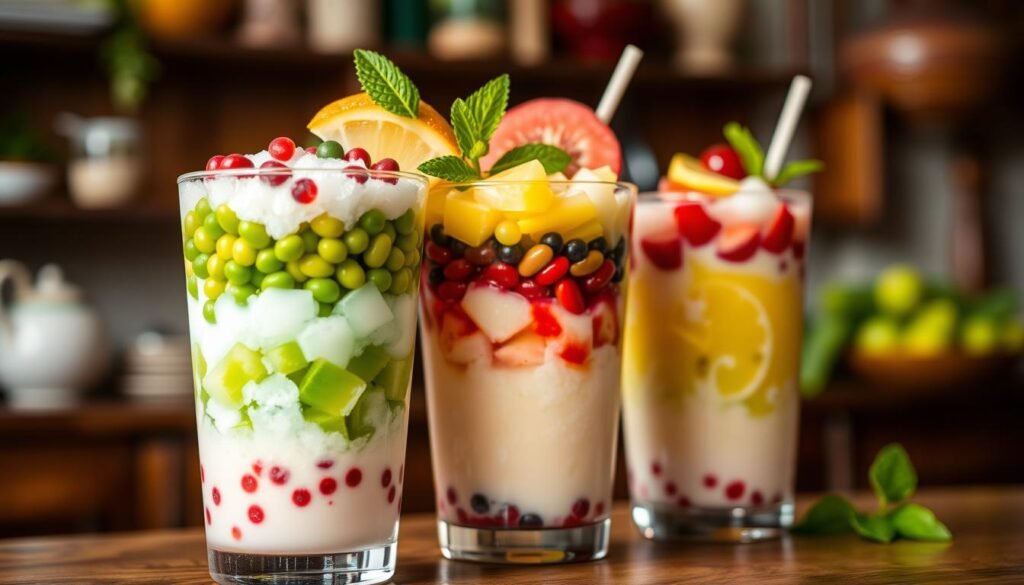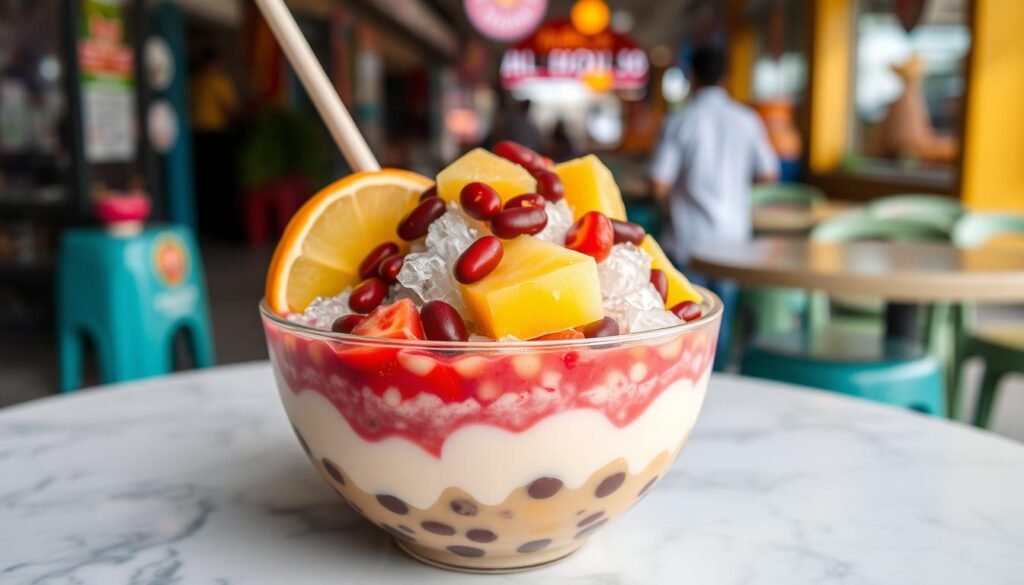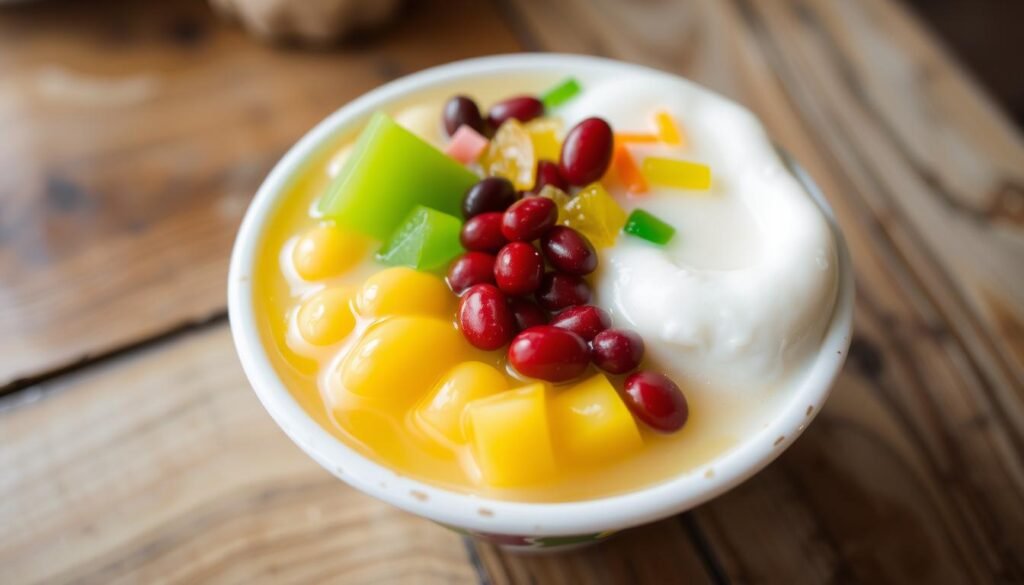I’m excited to introduce you to Vietnamese Che Ba Mau. It’s a three-color dessert that’s both fun and delicious. It has colorful layers made from pandan jelly, mung beans, and red beans. It’s topped with coconut cream.
Vietnamese Che Ba Mau is a standout dish. It’s fun to eat and looks amazing. With its three layers, it’s a feast for the eyes and taste buds. If you love trying new foods, you should try this.
What Makes Vietnamese Che Ba Mau Special
Che Ba Mau is a special dessert in Vietnamese culture. It’s often eaten at family gatherings and celebrations. It shows the harmony and balance of nature.
The Cultural Significance
Che Ba Mau is more than a dessert. It shows Vietnam’s rich culture. The three colors symbolize harmony and balance in nature.
Why Three Colors Matter
The colors of Che Ba Mau are meaningful. Red, yellow, and green bring good luck and prosperity. This makes it a favorite for celebrations.
My First Experience with Che Ba Mau
I remember trying Che Ba Mau at a Vietnamese New Year. The colors and flavors were amazing. It made me love this dessert forever.
The History Behind This Vibrant Dessert
Exploring the history of Vietnamese Che Ba Mau is fascinating. It shows the rich cultural heritage of this iconic dessert. The story of Che Ba Mau is about tradition, innovation, and community.
It started with Vietnamese customs and has grown over time. Different regions and ingredients have shaped it. Yet, the three-color dessert remains a symbol of Vietnamese unity and diversity.
The history of Che Ba Mau is also about the people and traditions. It has changed from a simple dessert to a beloved national treat. This journey has brought people together, creating a sense of community and shared identity.
The evolution of Che Ba Mau is interesting. It combines traditional and modern elements. The basic recipe stays the same, but regions add their own twists. This mix keeps the dessert exciting for everyone.
Thinking about Che Ba Mau’s history reminds us of the importance of cultural heritage. This dessert is more than a sweet treat. It represents Vietnamese identity and the strength of community and tradition. By learning about Vietnamese Che Ba Mau, we appreciate its cultural significance more.
Essential Ingredients for Vietnamese Che Ba Mau
To make a real Vietnamese three-color dessert, you need the right ingredients. Pandan jelly, mung beans, and red beans are key. They add color, flavor, and texture.
The Green Layer: Pandan Jelly
Pandan jelly is a main part of Vietnamese Che Ba Mau. It’s sweet and refreshing. It comes from pandan leaves, used a lot in Southeast Asia.
The Yellow Layer: Mung Beans
Mung beans make the yellow layer. They taste sweet and nutty. Mung beans are loved in Vietnamese food, used in many treats.
The Red Layer: Red Beans
Red beans make the red layer. They’re sweet and a bit nutty. Red beans are common in Vietnamese dishes, like desserts and soups.
The Coconut Cream Topping
The coconut cream topping is creamy and rich. It balances the dessert’s sweetness. It’s a must for Vietnamese Che Ba Mau, adding a creamy touch.
Traditional Preparation Methods
I’m excited to learn about making Che Ba Mau, a traditional Vietnamese dessert. It’s a mix of textures and tastes, with each part made with care. The old ways of making it show patience and detail, making sure each bit is just right.
First, we make each layer, like the pandan jelly, mung beans, and red beans. These are cooked in special ways, passed down through families. The pandan jelly gets its special taste from pandan leaves.
Then, we put the layers together in a tall glass or bowl. This makes the dessert look beautiful, with its three colors. The coconut cream on top adds a creamy touch.
Using the best ingredients and careful assembly is key. This makes Che Ba Mau taste and feel just right. I’m learning a lot about this dessert and its history.
Learning about Che Ba Mau is more than just recipes. It’s about the culture and history behind it. This dessert is a big part of Vietnamese tradition, connecting us to the past.
Modern Twists on Vietnamese Three-Color Dessert
I found that modern Vietnamese three-color desserts are getting more popular. They show how tastes and creativity are changing. This makes the old dessert more fun for more people.
New flavors like matcha or coconut are being used. Fruits like mango or durian are also added. Different places have their own favorite ingredients.
Popular Variations
Vegan versions of the dessert are now popular. They use plants to get the same taste. Some recipes are easier to make, so you can try it at home.
Regional Differences
Every place in Vietnam has its own twist on the dessert. Some use special beans or fruits. Others mix flavors in new ways. This makes the dessert even more interesting.
| Region | Unique Ingredient |
|---|---|
| Northern Vietnam | Lotus seeds |
| Southern Vietnam | Coconut milk |
Contemporary Adaptations
New versions of the dessert are coming out. They use cool ingredients and ways to cook. These updates keep the dessert alive and attract new fans.
Tips for Perfect Layering
Creating a stunning Vietnamese three-color dessert needs perfect layering. I cool and set each layer before adding the next. This patience is key for a beautiful dessert.
I use a level to make sure the layers are even. This is important for the dessert’s look. Choosing the right glass or bowl is also key. I pick a tall, clear one to show off the dessert’s colors.
When adding coconut cream, I pour it gently. This keeps the colors separate. These steps help make a Che Ba Mau that impresses everyone.

Remember, patience and detail are the keys to perfect layering. Taking time to set and even each layer makes a stunning dessert. Almost too beautiful to eat.
Serving and Presentation Guidelines
When serving Vietnamese three-color dessert, show off its bright layers. It’s best in tall, clear glasses or bowls. This lets the colors and textures shine.
Serving Che Ba Mau is like an art. It makes enjoying it a treat for the senses.
For the best taste, serve it cold. This brings out the flavors and textures. Adding garnishes can also make it look fancy. Try sesame seeds, fresh mint, or coconut cream on top.
| Serving Vessel | Garnishing Idea |
|---|---|
| Tall, clear glass | Sprinkle of sesame seeds |
| Clear bowl | Fresh mint leaves |
| Traditional Vietnamese bowl | Drizzle of coconut cream |
By focusing on these details, you can make Che Ba Mau look amazing. It becomes a special treat for everyone.
Best Places to Find Che Ba Mau in America
I love exploring Vietnamese desserts. I often wonder where to find Vietnamese three-color dessert in America. There are many places to try it. Popular Vietnamese dessert shops in big cities have Che Ba Mau.
Some shops even have their own special Che Ba Mau. Cities with more Vietnamese people have more places to try it. Online reviews and food blogs can help you find the best spots.
Popular Vietnamese Dessert Shops
These shops have many traditional Vietnamese desserts. Che Ba Mau is one of them. They also have other desserts you might like.

Regional Availability
Cities like San Jose, California, and Houston, Texas, have lots of options. But, Vietnamese desserts are getting more popular everywhere. So, you can find Che Ba Mau in many cities now.
| City | Popular Vietnamese Dessert Shops |
|---|---|
| San Jose, California | Pho 24, Vietnomz |
| Houston, Texas | Sweet Hut Bakery, Pho Binh |
| New York City, New York | Vietnam Banh Mi, Hanoi House |
Health Benefits and Nutritional Information
Exploring Vietnamese three-color dessert is exciting. It’s packed with health benefits thanks to its ingredients. Mung beans and red beans are full of protein and fiber, helping your digestion.
The pandan jelly is sweet but also has antioxidants. Coconut cream adds healthy fats, making it a treat you can feel good about. Knowing what’s in Che Ba Mau helps us see it as more than just a sweet treat.
Looking at the ingredients of Vietnamese three-color dessert is key. Mung beans, red beans, and pandan jelly offer lots of vitamins and minerals.
Overall, Vietnamese three-color dessert is a nutritious sweet treat. Its unique ingredients and traditional ways of making it make it both tasty and healthy. Adding Che Ba Mau to your diet brings health benefits and connects you to Vietnamese culture.
Conclusion: Why You Should Try This Vietnamese Treat
Exploring Vietnamese Che Ba Mau has been exciting. This dessert is not just pretty. It’s also full of flavors and textures that grab your attention. By trying Vietnamese three-color dessert, you get to enjoy a tasty treat and learn about Vietnamese culture.
Che Ba Mau is more than a dessert. It shows the creativity and skill of the Vietnamese people. It’s perfect for anyone who loves food, culture, or just great sweets. Trying it will surely make a big impression.
So, when you get to try Che Ba Mau, go all in. Let its flavors and colors take you on a journey. It’s a chance to slow down and enjoy something special. In today’s fast world, desserts like Che Ba Mau are true soul nourishers.

